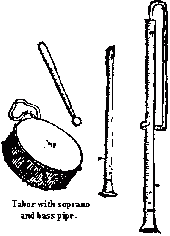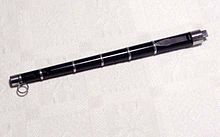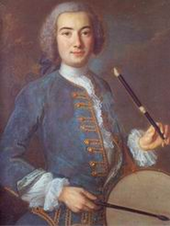- Pipe and tabor
-
Pipe and tabor 
Classification Playing range 1-2 octaves Related instruments - Tinwhistle
- Snare drum
- Fife and drum
Pipe and tabor is a pair of instruments played by a single player, consisting of a three-hole pipe played with one hand, and a small drum played with the other. The tabor (drum) hangs on the performer's left arm or around the neck, leaving the hands free to beat the drum with a stick in the right hand and play the pipe with thumb and first two fingers of the left hand.
The pipe is made out of wood, metal or plastic and consists of a cylindrical tube of narrow bore (1:40 diameter:length ratio) pierced with three holes near one end, two in front and one in back. At the opposite end is a fipple or block, similar to that used in a recorder.
Tabor pipes are widespread throughout the globe, found on most continents and in many countries. Each culture has developed a different style of pipe, so a different method of playing and a different range of notes. The smallest of the family is the Picco pipe, while the largest is the Fujara.
In Europe there are many variations of instrument. The pipe and tabor is depicted in illuminated manuscripts, carvings on ecclesiastical buildings in stone and wood, stained glass windows and early printed books.
Contents
Early descriptions
 As depicted by Michael Praetorius
As depicted by Michael Praetorius
Mersenne mentions a virtuoso, John Price, who could rise to the twenty-second on the galoubet. Praetorius mentions and illustrates three sizes of the Stamentienpfeiff, the treble 20 in. long, the tenor 26 in. and the bass 30, the last being played by means of a crook about 23 in. long. A specimen of the bass in the museum of the Brussels Conservatory has middle C for its lowest note.
English tradition and comparison with fife and drum
Fife and drum and pipe and tabor are both combinations of a wind instrument played in its upper register accompanied by a drums. The fife, however, is a transverse (side-blown) flute, whereas the pipe is a fipple flute. The fife requires two hands, and thus the drummer must be a separate person. The fife and drum are associated with military marching. The flute and drum played by two people came to the United Kinddom with the Swiss guards (Landsknecht)in the 17th century and became the fife and drum in late Georgian times (late 18th and early 19th centuries). The pipe and tabor has a much longer history and is associated with civilian music and Court etiquette. It was used for dancing (for all classes of society), ceremonies and processions, folk customs and street entertainment.
Three-hole pipes made from bone and dating to the early Middle Ages have been found in England.[1] There are images of medieval taborers in buildings, for example Lincoln and Gloucester cathedrals, and Tewkesbury Abbey.
In the plays of Shakespeare's time clowns performed between acts, often dancing to the music of pipe and tabor.[2]
The pipe and tabor are also known as 'whittle and dub' and 'whit and dub' in some parts of the country.[3] Pipe and tabor playing survived into the twentieth century. It was close to extinction in the early part of the century, but a revival of interest occurred and the English pipe and tabor tradition remains alive in morris dancing, early music and all manner of cultural displays.
In the twentieth century the makers of Generation pennywhistles introduced an economical English tabor pipe made of metal and with a plastic mouthpiece. The English tabor has changed shape through its history and is now seen in a range of sizes and shapes according to the whim of the player. Traditionally it is played with a snare on the upper face, but today is sometimes played without.
European tradition
Iberian Peninsula
The pipe and tabor, in various local forms, is popular in the Basque region. The txirula and txistu are three-hole tabor pipes tuned to the dorian mode.[4] The pipe and tabor (danbolin in Basque, flauta tamborileira or flauta pastoril in portuguese, fraita in mirandês - the second oficial language of Portugal - tamboril in Spanish) is often played by groups of players in the Basque country.[5]
Aside from its importance in the Basque region, in the Iberian Peninsula the pipe and tabor remains an important part of various regional traditions.
Provence
In Provence a form of tabor pipe called the galoubet is played. Its scale begins a third below that of the English tabor pipe. The galoubet is accompanied on an exceptionally deep tabor known as the tambourin.[5]
American tradition
Latin America
From Spain, the pipe and tabor was carried to the Americas, where it continues to be used in some folk traditions.[5] The Yaqui nation in Arizona and Mexico has its "Tamboristas", and the Tarahumara in the mountains of Chihuahua play a three-hole whistle (there is no back thumb hole) made from Arundo donax Cane. The tambor used with the whistle is a large diameter, double-headed skin drum. However, its wood frame, or shell, is very narrow, perhaps to save on total weight.
United States and Canada
The revival of the English pipe and tabor occurred to some extent throughout the Anglophone world, including the United States and Canada. One of the largest manufacturers of tabor pipes today is the Kelischeck Workshop, in North Carolina, makers of the Susato line of instruments.[6]
A similar tradition existed in the United States of playing the panpipes together with a tambourine.[7]
See also
References
- ^ Musical Report 1
- ^ The Project Gutenberg eBook of A History of Pantomime, by R. J. Broadbent
- ^ http://www.gutenberg.org/files/12926/12926-8.txt
- ^ Susato Tabor Pipes
- ^ a b c The Taborers Society
- ^ Tabor Pipe Reviews
- ^ http://www.lyon.edu/wolfcollection/songs/alphasongs.html#p Field notes and recordings of Joe Pat
External links
- The Taborer's Society
- A Plain and Easy Introduction to the English Pipe and Tabor
- Address to a Society of Morris Dancers, 1914 by Sir Francis Darwin
- The pipe and tambor in Alentejo, Portugal (in Portuguese)
- About the pipe and tambor in Portugal (in Portuguese)
- Portuguese parts (in Portuguese)
- Introductory Method for Tamborilero's Pipe (in Spanish)
- http://www.tamborileros.com (in Spanish)
- Construction of 3-hole pipe (in Spanish)
- http://www.txistulari.com (in Basque)
 Chisholm, Hugh, ed (1911). "Pipe and Tabor". Encyclopædia Britannica (11th ed.). Cambridge University Press.
Chisholm, Hugh, ed (1911). "Pipe and Tabor". Encyclopædia Britannica (11th ed.). Cambridge University Press.
Categories:- Percussion instruments
- European musical instruments
- Early musical instruments
- Fipple flutes
Wikimedia Foundation. 2010.



